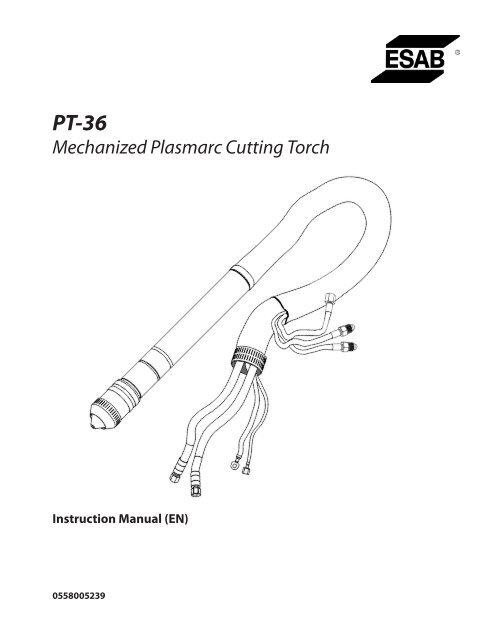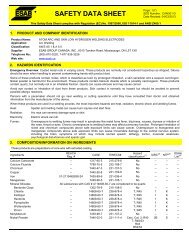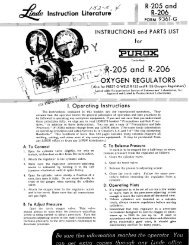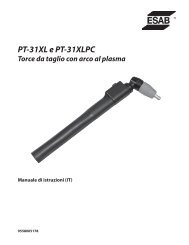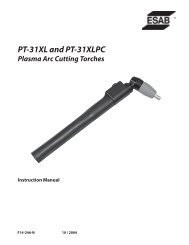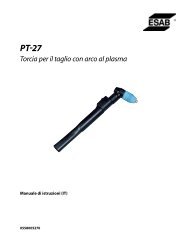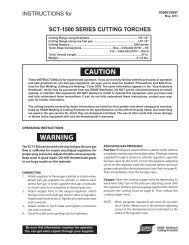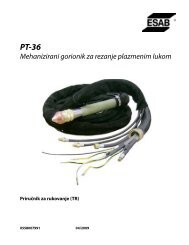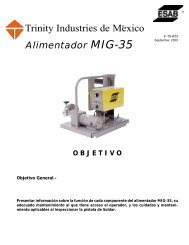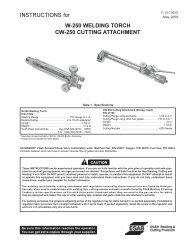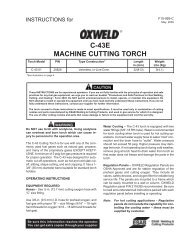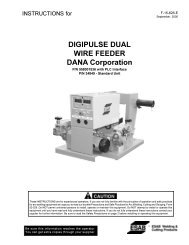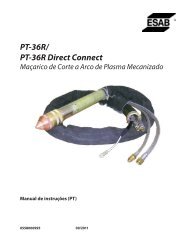PT-36 Mechanized Plasmarc Cutting Torch Instruction Manual
PT-36 Mechanized Plasmarc Cutting Torch Instruction Manual
PT-36 Mechanized Plasmarc Cutting Torch Instruction Manual
- No tags were found...
You also want an ePaper? Increase the reach of your titles
YUMPU automatically turns print PDFs into web optimized ePapers that Google loves.
Be sure this information reaches the operator.You can get extra copies through your supplier.cautionThese INSTRUCTIONS are for experienced operators. If you are not fully familiar with theprinciples of operation and safe practices for arc welding and cutting equipment, we urgeyou to read our booklet, “Precautions and Safe Practices for Arc Welding, <strong>Cutting</strong>, andGouging,” Form 52-529. Do NOT permit untrained persons to install, operate, or maintainthis equipment. Do NOT attempt to install or operate this equipment until you have readand fully understand these instructions. If you do not fully understand these instructions,contact your supplier for further information. Be sure to read the Safety Precautions beforeinstalling or operating this equipment.USER RESPONSIBILITYThis equipment will perform in conformity with the description thereof contained in this manual and accompanyinglabels and/or inserts when installed, operated, maintained and repaired in accordance with the instructionsprovided. This equipment must be checked periodically. Malfunctioning or poorly maintained equipmentshould not be used. Parts that are broken, missing, worn, distorted or contaminated should be replaced immediately.Should such repair or replacement become necessary, the manufacturer recommends that a telephoneor written request for service advice be made to the Authorized Distributor from whom it was purchased.This equipment or any of its parts should not be altered without the prior written approval of the manufacturer.The user of this equipment shall have the sole responsibility for any malfunction which results from improperuse, faulty maintenance, damage, improper repair or alteration by anyone other than the manufacturer or a servicefacility designated by the manufacturer.READ AND UNDERSTAND THE INSTRUCTION MANUAL BEFORE INSTALLING OR OPERATING.PROTECT YOURSELF AND OTHERS!132
table of contentsSection / TitlePage1.0 Safety Precautions ................................................................................. 1352.0 Description ........................................................................................ 1372.1 General . . . . . . . . . . . . . . . . . . . . . . . . . . . . . . . . . . . . . . . . . . . . . . . . . . . . . . . . . . . . . . . . . . . . . . . . . . . . . . . . . . . . . . . . 1372.2 Scope ......................................................................................... 1372.3 Package Options Available ..................................................................... 1372.4 Optional Accessories: ......................................................................... 1382.5 <strong>PT</strong>-<strong>36</strong> Technical Specifications..................................................................1413.0 Installation......................................................................................... 1433.1 Connection of <strong>Torch</strong> To Plasma System ........................................................ 1433.2 Mounting <strong>Torch</strong> to Machine .................................................................. 1444.0 Operation ......................................................................................... 1454.1 Set Up ......................................................................................... 1474.2 Cut Quality . . . . . . . . . . . . . . . . . . . . . . . . . . . . . . . . . . . . . . . . . . . . . . . . . . . . . . . . . . . . . . . . . . . . . . . . . . . . . . . . . . . 1474.3 <strong>Torch</strong> Flow Passages ......................................................................... 1525.0 Maintenance....................................................................................... 1535.1 Introduction ................................................................................ 1535.2 <strong>Torch</strong> Front End Disassembly.................................................................. 1545.3 <strong>Torch</strong> Front End Disassembly (for Production Thick Plate)....................................... 1575.4 Assembly Of <strong>Torch</strong> Front End ................................................................ 1605.5 Assembly of <strong>Torch</strong> Front End (for Production Thick Plate) ....................................... 1615.6 <strong>Torch</strong> Body . . . . . . . . . . . . . . . . . . . . . . . . . . . . . . . . . . . . . . . . . . . . . . . . . . . . . . . . . . . . . . . . . . . . . . . . . . . . . . . . . 1635.7 Removal and Replacement of the <strong>Torch</strong> Body .................................................. 1645.8 Reduced Consumable Life ................................................................... 167133
table of contents134
section 1safety precautions1.0 Safety PrecautionsUsers of ESAB welding and plasma cutting equipment have the ultimate responsibility for ensuring that anyonewho works on or near the equipment observes all the relevant safety precautions. Safety precautions must meetthe requirements that apply to this type of welding or plasma cutting equipment. The following recommendationsshould be observed in addition to the standard regulations that apply to the workplace.All work must be carried out by trained personnel well acquainted with the operation of the welding or plasmacutting equipment. Incorrect operation of the equipment may lead to hazardous situations which can result ininjury to the operator and damage to the equipment.1. Anyone who uses welding or plasma cutting equipment must be familiar with:- its operation- location of emergency stops- its function- relevant safety precautions- welding and / or plasma cutting2. The operator must ensure that:- no unauthorized person stationed within the working area of the equipment when it is started up.- no one is unprotected when the arc is struck.3. The workplace must:- be suitable for the purpose- be free from drafts4. Personal safety equipment:- Always wear recommended personal safety equipment, such as safety glasses, flame proofclothing, safety gloves.- Do not wear loose fitting items, such as scarves, bracelets, rings, etc., which could becometrapped or cause burns.5. General precautions:- Make sure the return cable is connected securely.- Work on high voltage equipment may only be carried out by a qualified electrician.- Appropriate fire extinquishing equipment must be clearly marked and close at hand.- Lubrication and maintenance must not be carried out on the equipment during operation.135
section 1safety precautionsWARNINGWELDING AND PLASMA CUTTING CAN BE INJURIOUS TO YOURSELFAND OTHERS. TAKE PRECAUTIONS WHEN WELDING OR CUTTING. ASKFOR YOUR EMPLOYER’S SAFETY PRACTICES WHICH SHOULD BE BASEDON MANUFACTURERS’ HAZARD DATA.ELECTRIC SHOCK - Can kill.- Install and earth (ground) the welding or plasma cutting unit in accordance with applicable standards.- Do not touch live electrical parts or electrodes with bare skin, wet gloves or wet clothing.- Insulate yourself from earth and the workpiece.- Ensure your working stance is safe.FUMES AND GASES - Can be dangerous to health.- Keep your head out of the fumes.- Use ventilation, extraction at the arc, or both, to take fumes and gases away from your breathing zoneand the general area.ARC RAYS - Can injure eyes and burn skin.- Protect your eyes and body. Use the correct welding / plasma cutting screen and filter lens and wearprotective clothing.- Protect bystanders with suitable screens or curtains.FIRE HAZARD- Sparks (spatter) can cause fire. Make sure therefore that there are no inflammable materials nearby.NOISE - Excessive noise can damage hearing.- Protect your ears. Use earmuffs or other hearing protection.- Warn bystanders of the risk.MALFUNCTION - Call for expert assistance in the event of malfunction.READ AND UNDERSTAND THE INSTRUCTION MANUAL BEFORE INSTALLING OR OPERATING.PROTECT YOURSELF AND OTHERS!1<strong>36</strong>
section 2DEscription2.1 GeneralThe <strong>PT</strong>-<strong>36</strong> <strong>Mechanized</strong> <strong>Plasmarc</strong> <strong>Cutting</strong> <strong>Torch</strong> is a plasma arc torch factory assembled to provide torch componentconcentricity and consistent cutting accuracy. For this reason, the torch body can not be rebuilt in the field.Only the torch front-end has replaceable parts.2.2 ScopeThe purpose of this manual is to provide the operator with all the information required to install and servicethe <strong>PT</strong>-<strong>36</strong> <strong>Mechanized</strong> <strong>Plasmarc</strong> <strong>Cutting</strong> <strong>Torch</strong>. Technical reference material is also provided to assist in troubleshootingthe cutting package.2.3 Package Options Available<strong>PT</strong>-<strong>36</strong> package options available through your ESAB dealer. See Replacement Parts section for component partnumbers.DESCRI<strong>PT</strong>IONS FOR <strong>PT</strong>-<strong>36</strong> TORCH ASSEMBLY'SPART NUMBER<strong>PT</strong>-<strong>36</strong> TORCH AY 4.5 ft (1,3m) 0558003849<strong>PT</strong>-<strong>36</strong> TORCH AY 6 ft (1,8m) 0558003850<strong>PT</strong>-<strong>36</strong> TORCH AY 12 ft (3,7m) 0558003852<strong>PT</strong>-<strong>36</strong> TORCH AY 15 ft (4,6m) 0558003853<strong>PT</strong>-<strong>36</strong> TORCH AY 17 ft (5,2m) 0558003854<strong>PT</strong>-<strong>36</strong> TORCH AY 25 ft (7,6m) 0558003856<strong>PT</strong>-<strong>36</strong> TORCH AY 14 ft MINI-BEVEL (4,3m) 0558005741137
section 2DEscription2.4 Optional Accessories:Test Flow Meter - This valuable troubleshooting tool allows measurement of the actualplasma gas flow through the torch................................................................................21317Bubble Muffler - When used in conjunction with a water pump recirculating waterfrom the table and by using compressed air, this device creates a bubble of air whichenables a <strong>PT</strong>-<strong>36</strong> <strong>Plasmarc</strong> <strong>Cutting</strong> <strong>Torch</strong> to be used underwater with slight sacrificeof cut quality. This system also permits operation above water as the flow of waterthrough the muffler reduces fume, noise, and arc U.V. Radiation).(for installation/operation instructions see manual 0558006722).............................. 37439Air Curtain - This device when supplied with compressed air is used to improve theperformance of the <strong>PT</strong>-<strong>36</strong> <strong>Plasmarc</strong> <strong>Cutting</strong> <strong>Torch</strong> when cutting underwater. The devicemounts onto the torch and produces a curtain of air. This allows the plasma arc tooperate in a relatively dry zone, even though the torch has been submerged to reducenoise, fume, and arc radiation. To be used in underwater applications only.(for installation/operation instructions see manual 0558006404)..............................374402.4.1 <strong>PT</strong>-<strong>36</strong> <strong>Torch</strong> Consumable Kits<strong>PT</strong>-<strong>36</strong> Repair & Accessories Kit ....................................................................................0558005221Part Number Quantity Description0558003804 1 <strong>Torch</strong> Body <strong>PT</strong>-<strong>36</strong> w/O-rings996528 10 O-ring 1.614 ID x .0700558002533 2 Baffle, 4 Hole x .0320558001625 2 Baffle, 8 Hole x .0470558002534 1 Baffle, 4 x .032 Reverse0558002530 1 Baffle, 8 x .047 Reverse0558005457 1 Baffle, 4 Hole x .0220558003924 3 Electrode Holder <strong>PT</strong>-<strong>36</strong> w/O-ring86W99 10 O-ring .<strong>36</strong>4 ID x .07037082 2 Nozzle Retaining Cup, Standard21796 1 Shield Gas Diffuser, Low Current21944 5 Shield Gas Diffuser, Standard22496 1 Shield Gas Diffuser, Reverse37081 2 Shield Retainer, Standard0558003858 2 Contact Ring w/screw37073 6 Screw, Contact Ring93750010 2 Hex Key Wrench .109"996568 1 Nut Driver 7/16" (Electrode tool)0558003918 1 Electrode Holder Tool <strong>PT</strong>-<strong>36</strong>77500101 1 Silicon Grease DC-111 5.3oz138
section 2DEscription<strong>PT</strong>-<strong>36</strong> 200A Start-up Kit................................................................................................0558005222Part Number Quantity Description0558003914 8 Electrode O2 UltraLife, Standard0558003928 3 Electrode N2/H35, Standard0558005459 3 Electrode O2/N2, Low Current0558006010 3 Nozzle <strong>PT</strong>-<strong>36</strong> 1.0mm (.040")0558006014 3 Nozzle <strong>PT</strong>-<strong>36</strong> 1.4mm (.055")0558006020 5 Nozzle <strong>PT</strong>-<strong>36</strong> 2.0mm (.080")0558006130 3 Shield <strong>PT</strong>-<strong>36</strong> 3.0mm (.120")0558006141 3 Shield <strong>PT</strong>-<strong>36</strong> 4.1mm (.160")0558008010 3 Nozzle <strong>PT</strong>-<strong>36</strong> 1.0mm (.040") PR0558007624 3 Shield <strong>PT</strong>-<strong>36</strong> 2.4mm (.095")0558006023 3 Nozzle <strong>PT</strong>-<strong>36</strong> 2.3mm (.090")0558006166 3 Shield <strong>PT</strong>-<strong>36</strong> 6.6mm (.259")0558006908 3 Nozzle <strong>PT</strong>-<strong>36</strong> 0.8mm (.030")0558006018 3 Nozzle <strong>PT</strong>-<strong>36</strong> 1.8mm (.070")<strong>PT</strong>-<strong>36</strong> 400A Start-up Kit................................................................................................0558005223Part Number Quantity Description0558003914 5 Electrode O2 UltraLife, Standard0558007791 5 Electrode, High Current O20558003928 3 Electrode N2/H35, Standard0558005459 3 Electrode O2/N2, Low Current0558006010 2 Nozzle <strong>PT</strong>-<strong>36</strong> 1.0mm (.040")0558006014 2 Nozzle <strong>PT</strong>-<strong>36</strong> 1.4mm (.055")0558006020 5 Nozzle <strong>PT</strong>-<strong>36</strong> 2.0mm (.080")0558006023 3 Nozzle <strong>PT</strong>-<strong>36</strong> 2.3mm (.090")0558006025 3 Nozzle <strong>PT</strong>-<strong>36</strong> 2.5mm (.099")05580060<strong>36</strong> 3 Nozzle <strong>PT</strong>-<strong>36</strong> 3.6mm (.141")0558006130 3 Shield <strong>PT</strong>-<strong>36</strong> 3.0mm (.120")0558006141 3 Shield <strong>PT</strong>-<strong>36</strong> 4.1mm (.160")0558006166 3 Shield <strong>PT</strong>-<strong>36</strong> 6.6mm (.259")0558008010 3 Nozzle <strong>PT</strong>-<strong>36</strong> 1.0mm (.040") PR0558007624 3 Shield <strong>PT</strong>-<strong>36</strong> 2.4mm (.095")0558006199 3 Shield <strong>PT</strong>-<strong>36</strong> 9.9mm (.390")0558006908 3 Nozzle <strong>PT</strong>-<strong>36</strong> 0.8mm (.030")0558006018 3 Nozzle <strong>PT</strong>-<strong>36</strong> 1.8mm (.070")0558006030 3 Nozzle <strong>PT</strong>-<strong>36</strong> 3.0mm (.120")139
section 2DEscription<strong>PT</strong>-<strong>36</strong> 600A Start-up Kit................................................................................................0558005224Part Number Quantity Description0558003914 5 Electrode O2 UltraLife, Standard0558007791 5 Electrode, High Current O20558003928 3 Electrode N2/H35, Standard0558005459 3 Electrode O2/N2, Low Current0558006010 2 Nozzle <strong>PT</strong>-<strong>36</strong> 1.0mm (.040")0558006014 2 Nozzle <strong>PT</strong>-<strong>36</strong> 1.4mm (.055")0558006020 5 Nozzle <strong>PT</strong>-<strong>36</strong> 2.0mm (.080")0558006023 3 Nozzle <strong>PT</strong>-<strong>36</strong> 2.3mm (.090")0558006025 3 Nozzle <strong>PT</strong>-<strong>36</strong> 2.5mm (.099")05580060<strong>36</strong> 3 Nozzle <strong>PT</strong>-<strong>36</strong> 3.6mm (.141")0558006041 3 Nozzle <strong>PT</strong>-<strong>36</strong> 4.1mm (.161")0558006130 3 Shield <strong>PT</strong>-<strong>36</strong> 3.0mm (.120")0558006141 3 Shield <strong>PT</strong>-<strong>36</strong> 4.1mm (.160")0558006166 3 Shield <strong>PT</strong>-<strong>36</strong> 6.6mm (.259")0558006199 3 Shield <strong>PT</strong>-<strong>36</strong> 9.9mm (.390")0558008010 3 Nozzle <strong>PT</strong>-<strong>36</strong> 1.0mm (.040") PR0558007624 3 Shield <strong>PT</strong>-<strong>36</strong> 2.4mm (.095")0558006908 3 Nozzle <strong>PT</strong>-<strong>36</strong> 0.8mm (.030")0558006018 3 Nozzle <strong>PT</strong>-<strong>36</strong> 1.8mm (.070")0558006030 3 Nozzle <strong>PT</strong>-<strong>36</strong> 3.0mm (.120")<strong>PT</strong>-<strong>36</strong> H35 Heavy Plate Start-up Kit.............................................................................0558005225Part Number Quantity Description0558003963 5 Electrode, Tungsten 3/16"D0558003965 5 Nozzle H35 .198" Divergent0558003964 2 Collet 3/16"D Electrode0558005689 2 Electrode/Collet Holder <strong>PT</strong>-<strong>36</strong>0558003967 2 Collet Body0558002532 2 Baffle, 32 Hole x .0230558006688 5 Shield High Current0558003918 1 Electrode Holder Tool <strong>PT</strong>-<strong>36</strong>0558003962 1 Tungsten Electrode Tool0558006690 2 Nozzle Retaining Cup Assy High Current140
section 2DEscription2.5 <strong>PT</strong>-<strong>36</strong> Technical Specifications2.5.1 Gas SpecificationsArgonNitrogenOxygen125 PSI (8,6 bar) with 0.25” N<strong>PT</strong>, 99.995% purity, Filtered to 25 microns125 PSI (8,6 bar) with 0.25” N<strong>PT</strong>, 99.99% purity, Filtered to 25 microns125 PSI (8,6 bar) with 0.25” N<strong>PT</strong>, 99.5% purity, Filtered to 25 micronsH-35 (Argon/Hydrogen) 75 PSI (5,2 bar), Speciality Gas, 99.995% purity, Filtered to 25 micronsMethaneCompressed Air(Clean, dry & oil-free shop air)75 PSI (5,2 bar) with 0.25” N<strong>PT</strong>, 93% purity, Filtered to 25 microns80 PSI @ 1200cfh (5,5 bar @ 35 m 3 h), Filtered to 25 micronsTypical requirements for flow delivered at 125 psig: Maximum Plasma Gas: 300 scfh Maximum Shield Gas: 350 scfhNote:These do not represent actual flows used in any condition, but are the design maximums of the system.2.5.2 <strong>PT</strong>-<strong>36</strong> <strong>Torch</strong> Technical SpecificationsType: Water cooled, Dual gas, mechanized plasmarc cutting torchCurrent Rating: 1000 Amps @ 100% duty cycleMounting Diameter: 2 inches (50.8 mm)Length of <strong>Torch</strong> without leads: 16.7 inches (42 cm)IEC 60974-7 Voltage Rating: 500 volts peakStriking Voltage (maximum value of HI-FREQUENCY voltage): 8000 vacMinimum Coolant Flowrate: 1.3 USGPM (5.9 l/min)Minimum Coolant Pressure at Inlet: 175 psig (12.1 bars)Maximum Coolant Pressure at Inlet: 200 psig (13.8 bar)Minimum Acceptable Rating of Coolant Recirculator:16,830 BTU/HR (4,9 kW) at High Coolant Temperature - Ambient = 45 ° F (25 ° C) and 1.6 USGPM (6 L/min)Maximum Safe Gas Pressures at Inlets to <strong>Torch</strong>: 125 psig (8.6 bars)Safety Interlocks: This torch is intended for use with ESAB <strong>Plasmarc</strong> cutting systems and controls employing a water flowswitch on the coolant return line from the torch. Removal of the nozzle retaining cup to service the torch breaks thecoolant return path.141
section 2DEscription142
section 3INstallation3.1 Connection of <strong>Torch</strong> To Plasma SystemRefer to system manual.DANGERElectric Shock Can Kill!• Disconnect primary power source before making any adjustments.• Disconnect primary source before doing maintenance on systemcomponents.• Do not touch front-end torch parts (nozzle, retaining cup, etc.) withoutturning primary power off.WARNINGRadiation hazard. Arc rays can injure eyes and burn skin.• Wear correct eye and body protection.• Wear dark safety glasses or goggles with side shields. Refer to following chart forrecommended lens shades for plasma cutting:Arc CurrentLens ShadeUp to 100 Amps Shade No. 8100-200 Amps shade No. 10 200-400 Amps Shade No. 12Over 400 Amps shade No. 14• Replace glasses/goggles when lenses are pitted or broken• Warn others in area not to look directly at the arc unless wearing appropriate safetyglasses.• Prepare cutting area to reduce reflection and transmission of ultraviolet light.• Install protective screens or curtains to reduce ultraviolet transmission.3.1.1 Connection to the Arc Starter BoxThe <strong>PT</strong>-<strong>36</strong> has two water cooled power cables which must be connected to the negative output from the powersupply. The right handed 7/16-20 fitting is on the cable supplying coolant to the torch. The left handed 7/16-20fitting is on the cable returning coolant from the torch.The ring terminal is used to make the nozzle connection for pilot arc starting. The fast-on connection groundsthe braided shield on the pilot arc cable.Male fast-onconnectionBrass nutAn alternative braided shield connection is provided on thetorch. The female fast-on connection (normally in the arcstarter box) can instead be mated to a male fast-on connectiontaped to one of the power cables a few inches beforethe end of the torch sleeving. Push the sleeving and largebrass nut towards the head of the torch to reveal this connection.When this connection is made, the shield connectionis grounded through the large brass nut.Female fast-on connectionpower cables (2)143
section 3INstallation3.1.2 Connection of Gas Hoses1 - Female old-style air water nut for Shield Gas connection.12 - B-IG fittings for Plasma Start gas and Plasma Cut gas.Either hose can be attached in either location.23.2 Mounting <strong>Torch</strong> to MachineRefer to machine manual.cautionClamping on <strong>Torch</strong> Body May Cause Dangerous Current To FlowThrough Machine Chassis.Mount torch on insulated sleeve hereDO NOT mounton steel torchbody here• Do not mount on stainless steel torch body.• <strong>Torch</strong> body is electrically insulated, however high frequencystart current may arc through to find a ground.• Clamping near torch body may result in arcing betweenbody and machine.• When this arcing occurs, torch body may require non-warrantyreplacement.• Damage to machine components may result.• Clamp only on insulated torch sleeve (directly above label)not less than 1.25" (31.75mm) from the torch end ofthe sleeve.144
section 4operationWARNINGOil And Grease Can Burn Violently!• Never use oil or grease on this torch.• Handle torch clean hands only on clean surface.• Use silicone lubricant only where directed.• Oil and grease are easily ignited and burn violently in the presenceof oxygen under pressure.WARNINGHydrogen explosion hazard.• Do not cut under water with Hydrogen gas!• Hydrogen explosions can cause personal injury ordeath.• Hydrogen can create explosive gas pockets in the watertable. These pockets will explode when ignited bysparks or the plasma arc.• Before cutting, be aware of possible hydrogen sourcesin the water table – molten metal reaction, slowchemical reaction and some plasma gases.• Explosive gas pockets accumulate underneath thecutting plate and inside the water table.• Clean slag (especially fine particles) from bottom oftable frequently. Refill table with clean water.• Do not leave plate on table overnight.• If water table has not been used for several hours, vibrateor jolt it to break up hydrogen pockets beforelaying plate on the table.• If possible, change water level between cuts to breakup hydrogen pockets.• Maintain water pH level near 7 (neutral).• Programmed part spacing should be a minimum oftwice the kerf width to ensure material is always underthe kerf.• When cutting above water, use fans to circulate airbetween plate and water surface.WARNINGExplosion Hazard.Do Not Cut Underwater With H-35! Dangerous buildup ofhydrogen gas is possible in the water table. Hydrogen gasis extremely explosive. Reduce the water level to 4 inchesminimum below the workpiece. Vibrate plate, stir air andwater frequently to prevent hydrogen gas buildup.145
section 4operationWARNINGExplosion hazard.Certain molten aluminum-lithium (Al-Li) alloys can causeexplosions when plasma cut with water.Do not plasma cut the following Al-Li alloys with water:Alithlite (Alcoa)X8192 (Alcoa)Alithally (Alcoa)Navalite (US Navy)2090 Alloy (Alcoa) Lockalite (Lockheed)X8090A (Alcoa)Kalite (Kaiser)X8092 (Alcoa)8091 (Alcan)• These alloys should only be dry cut on a dry table.• DO NOT dry cut over water.• Contact your aluminum supplier for additionalsafety information regarding hazards associatedwith these alloys.WARNINGSpark hazard.Heat, spatter, and sparks cause fire and burns.• Do not cut near combustible material.• Do not cut containers that have held combustibles.• Do not have on your person any combustibles (e.g.butane lighter).• Pilot arc can cause burns. Keep torch nozzle awayfrom yourself and others when activating plasmaprocess.• Wear correct eye and body protection.• Wear gauntlet gloves, safety shoes and hat.• Wear flame-retardant clothing that covers all exposedareas.• Wear cuffless trousers to prevent entry of sparksand slag.146
section 4operationWARNINGOil And Grease Can Burn Violently!• Never use oil or grease on this torch. • Handle torch clean hands onlyon clean surface.• Use silicone lubricant only where directed.• Oil and grease are easily ignited and burn violently in the presenceof oxygen under pressure.4.1 Set Up•••••Select an appropriate condition from the process data (SDP File) and install recommended torch frontendparts (nozzle, electrode, etc.) See process data to identify parts and settings.Position torch over material at desired start location.See Power Source <strong>Manual</strong> for proper settings.See Flow Control <strong>Manual</strong> for gas control procedures.See Control and Machine <strong>Manual</strong>s for startup procedures.4.1.1 Mirror <strong>Cutting</strong>When mirror cutting, a reverse swirl gas baffle and reverse diffuser are required. These reverse parts will “spin”the gas in the opposite direction, reversing the “good” side of the cut.Reverse 4 Hole Baffle P/N 0558002534Reverse 8 x .047 Baffle P/N 0558002530Reverse 8 x .067 Baffle P/N 209184.2 Cut QualityReverse Diffuser P/N 22496A. IntroductionCauses affecting cut quality are interdependent. Changing one variable affects all others. Determining a solutionmay be difficult. The following guide offers possible solutions to different undesirable cutting results. Tobegin select the most prominent condition:4.2.2 Cut Angle, negative or positive4.2.3 Cut Flatness4.2.4 Surface finish4.2.5 Dross4.2.6 Dimensional AccuracyUsually the recommended cutting parameters will give optimal cut quality, occasionally conditions may varyenough that slight adjustments will be required. If so:•••Make small incremental adjustments when making corrections.Adjust Arc Voltage in 5 volt increments, up or down as required.Adjust cutting speed 5% or less as required until conditions improve.147
section 4operationcautionBefore attempting ANY corrections, check cutting variables with thefactory recommended settings/consumable part numbers listed inProcess Data.4.2.2. Cut AngleNegative Cut AngleTop dimension is greater than the bottom.•••••Misaligned torchBent or warped materialWorn or damaged consumablesStandoff low (arc voltage)<strong>Cutting</strong> speed slow (machine travel rate)PartDropPartPositive Cut AngleTop dimension is less than the bottom dimension.••••••Misaligned torchBent or warped materialWorn or damaged consumablesHigh standoff High (arc voltage)<strong>Cutting</strong> speed fastCurrent high or low. (See Process Data for recommendedcurrent level for specific nozzles).PartDropPart148
section 4operation4.2.3. Cut FlatnessTop And Bottom Rounded. Condition usually occurs whenmaterial is .25" thick (6,4mm) or less.•High current for given material thickness (See ProcessData for proper settings).DropPartTop Edge Undercut•Standoff low (Arc Voltage)DropPart149
section 4operation4.2.4. Surface FinishProcess Induced RoughnessCut face is consistently rough. May or may not be confined toone axis.• Incorrect Shield Gas mixture (See Process Data).• Worn or damaged consumables.Top ViewCut FaceMachine Induced RoughnessCan be difficult to distinguish from Process Induced Roughness.Often confined to only one axis. Roughness is inconsistent.• Dirty rails, wheels and/or drive rack/pinion. (Referto Maintenance Section in machine operationmanual).• Carriage wheel adjustment.ProcessInducedRoughnessorMachineInducedRoughness4.2.5. DrossDross is a by-product of the cutting process. It is the undesirable materialthat remains attached to the part. In most cases, dross can bereduced or eliminated with proper torch and cutting parameter setup.Refer to Process Data.High Speed DrossMaterial weld or rollover on bottom surface along kerf. Difficult to remove.May require grinding or chipping. “S” shaped lag lines.••Standoff high (arc voltage)<strong>Cutting</strong> speed fastLag LinesSide ViewCut FaceRolloverSlow Speed DrossForms as globules on bottom along kerf. Removes easily.Lag LinesCut Face•<strong>Cutting</strong> speed slowGlobulesSide View150
section 4cautionoperationRecommended cutting speed and arc voltage will give optimal cuttingperformance in most cases. Smallincremental adjustments maybe needed due to material quality, material temperature and specificalloy. The operator should remember that all cutting variables are interdependent.Changing one setting affects all others and cut qualitycould deteriorate. Always start at the recommended settings.Top DrossAppears as splatter on top of material. Usually removes easily.• <strong>Cutting</strong> speed fast• Standoff high (arc voltage)Intermittent DrossAppears on top or bottom along kerf. Non-continuous. Can appear asany kind of dross.Side ViewSplatter•Possible worn consumablesOther Factors Affecting Dross;Cut Face•••Material temperatureHeavy mill scale or rustHigh carbon alloyscautionBefore attempting ANY corrections, check cutting variables with thefactory recommended settings/consumable part numbers listed inthe Process Data.4.2.6. Dimensional AccuracyGenerally using the slowest possible speed (within approved levels) will optimize part accuracy. Select consumables to allowa lower arc voltage and slower cutting speed.noticeRecommended cutting speed and arc voltage will give optimal cuttingperformance.Small incremental adjustments may be needed due to material quality,material temperature and specific alloy. The operator should rememberthat all cutting variables are interdependent. Changing onesetting affects all others and cut quality could deteriorate. Alwaysstart at the recommended settings. Before attempting ANY corrections,check cutting variables with the factory recommended settings/consumable part numbers listed in the process data.151
section 4operation4.3 <strong>Torch</strong> Flow Passagesplasma gas inshield gas inwater inwater outView showing gas passages152View showing water passages
section 5Maintenance5.1 IntroductionWear on torch parts is a normal occurrence to plasma cutting. Starting a plasma arc is an erosive process to boththe electrode and nozzle. Regularly scheduled inspection and replacement of <strong>PT</strong>-<strong>36</strong> parts must take place tomaintain cut quality and consistent part size.DANGERHydrogen explosion hazard.A hazard exists whenever a water table is used for plasma arc cutting operations withoutfollowing recommended practices for safe operation. Severe explosions have resultedfrom the accumulation of hydrogen beneath the plate being cut. Thousands of dollarsin property damage has been caused by these explosions. Personal injury or death couldresult if people are struck by flying debris from the explosion.The best available information indicates three possible sources of hydrogen in water tables.Most of the hydrogen is liberated by a fast reaction of molten metal from the kerfwith the water to form metallic oxides. This reaction explains why reactive metals with agreat affinity for oxygen, such as aluminum and magnesium, release greater volumes ofhydrogen during the cut than iron does. Most of this hydrogen will come immediately tothe surface, but some of it will cling to small metallic particles. These particles will settle tothe bottom of the water table and the hydrogen will gradually bubble to the surface.Hydrogen may also result from slower chemical reactions of cold metal particles with thewater, dissimilar metals, or chemicals in the water table. This hydrogen will also graduallybubble to the surface.Finally, hydrogen may come from the plasma gas if H-35 is used. This gas is 35 percenthydrogen by volume and a total of about 70 cfh of hydrogen will be released.The hydrogen gas can collect in several places. The most common is in pockets formed bythe plates being cut and slats on the table. Pockets may also be formed in warped plates.There can also be an accumulation of hydrogen under the slag tray or even in the air reservoir.This hydrogen, in the presence of oxygen, can then be ignited by the plasma arc or aspark from any source. To reduce chances of hydrogen generation and accumulation, anda consequent explosion, the following practices are recommended:1. Clean the refuse (particularly fine particles) from the bottom of the table frequently.Refill the table with clean water.2. Do not leave plates on the cutting table overnight or over weekends.3. If water tables have been sitting idle for several hours, vibrate the table in some waybefore the first plate is laid in position. This will allow accumulated hydrogen in therefuse to break loose and dissipate before it is confined by a plate on the table. Thismight be accomplished by laying the first plate onto the table with a slight jolt, thenraising it again to permit hydrogen to escape before it is finally positioned.4. If cutting above water, install fans to circulate air between the plate and the water.5. If cutting under water, agitate the water under the plate to prevent accumulations ofhydrogen. This can be done by aerating the water using compressed air.6. The level in the water table can be raised and lowered between cuts to dissipate accumulatedhydrogen.7. Maintain pH level of the water near 7 (neutral). This should reduce the rate of chemicalreaction between water and metals.153
section 5Maintenance5.2 <strong>Torch</strong> Front End DisassemblyDANGERHot <strong>Torch</strong> Will Burn Skin!Allow torch to cool before servicing.1. Remove shield retainer.NOTE:If the shield retainer is difficult to remove, try to screw the nozzle retainer tighter to relieve pressure onthe shield.2. Inspect mating metal surface of shield and retainer for nicks or dirt that might prevent these two parts fromforming a metal to metal seal. Look for pitting or signs of arcing inside the shield. Look for melting of theshield tip. Replace if damaged.3. Inspect diffuser for debris and clean as necessary. Wear on the top notches does occur, effecting gas volume.Replace this part every other shield replacement. Heat from cutting many small parts in a concentrated areaor when cutting material greater than 0.75" (19.1mm) may require more frequent replacement.<strong>Torch</strong>bodyShield CupRetainerShieldCupDiffuserNozzleElectrodeElectrodeRemovalToolNozzle Retaining Cup154
section 5MaintenancecautionIncorrect assembly of the diffuser in the shield will prevent the torchfrom working properly. Diffuser notches must be mounted awayfrom the shield as illustrated.4. Unscrew nozzle retainer and pull nozzle straight out of torch body. Inspect insulator portion of the nozzleretainer for cracks or chipping. Replace if damaged.Inspect nozzle for:• melting or excessive current transfer• gouges from internal arcing• nicks or deep scratches on the O-ring seating surfaces• O-ring cuts, nicks, or wear• Remove hafnium particles (from the electrode) with steel woolReplace if any damage is found.NOTE:Discoloration of internal surfaces and small black starting marks are normal and do not effect cuttingpeformance.If the holder was tightened sufficiently, the electrode may unscrew without being attached to the electrodeholder. When installing the electrode, use only sufficient force to adequately secure the electrode.5. Remove electrode using electrode removal tool.6. Disassemble electrode from electrode holder. Insert flats on the holder into a 5/16" wrench. Using the electrodetool, rotate electrode counter-clockwise to remove. Replace electrode if center insert is pitted morethan 0.09" (3/32").<strong>Torch</strong>bodyElectrodeRemovalToolElectrodeReplace electrode if center insert ispitted more than 0.09" (3/32")155
section 5Maintenance7. Remove electrode holder from torch body. Hex on the end of the electrode holder removal tool will engagein a hex in the holder.RemovalToolGas BaffleElectrode Holder AssemblyElectrodeNOTE:The electrode holder is manufactured in two pieces. Do not disassemble. If the holder is damaged, replacethe electrode holder assembly.8. Disassemble electrode holder and gas baffle. Carefully remove O-ring from electrode holder and slide bafflefrom holder. Inspect nozzle seating surface (front edge) for chips. Look for cracks or plugged holes. Do notattempt to clear holes. Replace baffle if damaged.NOTE:Check all O-rings for nicks or other damage that might prevent O-ring from forming a gas/water tightseal.Electrode Holder AssemblyO-ringGas Baffle156
section 5Maintenance5.3 <strong>Torch</strong> Front End Disassembly (for Production Thick Plate)DANGERHot <strong>Torch</strong> Will Burn Skin!Allow torch to cool before servicing.1. Remove the Shield Cup Retainer.NOTE:If the shield cup retainer is difficult to remove, try to screw the nozzle retaining cup tighter to relieve pressureon the shield cup retainer.2. Inspect mating metal surface of shield cup and shield cup retainer for nicks or dirt that might prevent thesetwo parts from forming a metal to metal seal. Look for pitting or signs of arcing inside the shield cup. Lookfor melting of the shield tip. Replace if damaged.3. Inspect diffuser for debris and clean as necessary. Wear on the top notches does occur, effecting gas volume.Replace this part every other shield replacement. Heat from cutting many small parts in a concentrated areaor when cutting material greater than 0.75" (19.1mm) may require more frequent replacement.cautionIncorrect assembly of the diffuser in the shield will prevent the torchfrom working properly. Diffuser notches must be mounted awayfrom the shield as illustrated.Diffuser<strong>Torch</strong> BodyNozzleShield CupNozzle Retaining CupShield Cup Retainer157
section 5Maintenance4. Unscrew nozzle retainer and pull nozzle straight out of torch body. Inspect insulator portion of the nozzleretainer for cracks or chipping. Replace if damaged.Inspect nozzle for:• melting or excessive current transfer.• gouges from internal arcing.• nicks or deep scratches on the O-ringseating surfaces.• O-ring cuts, nicks, or wear.• Remove tungsten particles (from thenozzle) with steel wool.<strong>Torch</strong> BodyNozzle Retaining CupReplace if any damage is found.NozzleNOTE:Discoloration of internal surfaces and small black starting marks are normal and do not effect cuttingperformance.If the holder was tightened sufficiently, the electrode may unscrew without being attached to the electrodeholder. When installing the electrode, use only sufficient force to adequately secure the electrode.5. Remove electrode using electrode removal tool.6. Disassemble electrode from electrode holder. Insert flats on the holder into a 5/16" wrench. Using the electrodetool, rotate electrode counter-clockwise to remove. Replace electrode if center is pitted more than0.06" (1/16") or if the flat has become irregular in shape or is worn to a larger diameter.<strong>Torch</strong> BodyNote:The electrode has two usable ends. Whenone end is worn, flip electrode to other endfor continued use.ElectrodeElectrode Removal ToolCollet BodyElectrode/Collet HolderElectrode, Tungsten158
section 5Maintenance7. Remove electrode holder from torch body. Hex on the end of the electrode holder removal tool will engagein a hex in the holder.<strong>Torch</strong> BodyElectrode HolderRemoval Tool8. Disassemble electrode holder and gas baffle. Carefully remove O-ring from electrode holder and slide bafflefrom holder. Inspect nozzle seating surface (front edge) for chips. Look for cracks or plugged holes. Do notattempt to clear holes. Replace baffle if damaged.NOTE:Check all O-rings for nicks or other damage that might prevent O-ring from forming a gas/water tightseal.Electrode HolderGas BaffleO-ring (located underneath baffle)Pull Gas Baffle backto remove and accesso-ring159
section 5Maintenance5.4 Assembly Of <strong>Torch</strong> Front EndcautionOver tightened Parts Will Be Difficult To Disassemble And May Damage<strong>Torch</strong>. Do not over tighten parts during reassembly. Threadedparts are designed to work properly when hand tightened, approximately40 to 60 inch/pounds.••••Reverse order of disassembly.Apply a thin coat of silicone grease to O-rings before assembling mating parts. This facilitates easyfuture assembly and disassembly for service.Hand-tighten threaded parts.Installing the electrode requires only moderate hand tightening. Electrode holder should always bemade tighter than the electrode.NOTE:When assembling, place the nozzle inside the nozzle retaining cup and thread the retainer/nozzle combinationon the torch body. This will help align the nozzle with the assembly. The shield cup and shieldcup retainer should be installed only after installing the nozzle retaining cup and nozzle. Otherwise theparts will not seat properly and leaks may occur.DiffuserNozzleElectrode<strong>Torch</strong>bodyShieldCupNozzle RetainingCupShield Cup Retainer160
section 5Maintenance5.5 Assembly of <strong>Torch</strong> Front End (for Production Thick Plate)cautionOver tightened parts will be difficult to disassemble and may damagetorch. Do not over tighten parts during reassembly. Threadedparts are designed to work properly when hand tightened, approximately40 to 60 inch/pounds.••••Reverse order of disassembly.Apply a thin coat of silicone grease to O-rings before assembling mating parts. This facilitates easyfuture assembly and disassembly for service.Hand-tighten threaded parts.Installing the electrode requires only moderate hand tightening. Electrode holder should always bemade tighter than the electrode.<strong>Torch</strong> Body1. Replace electrode holder in torch body. Hex on theend of the electrode holder removal tool will engagein a hex in the holder.Collet BodyElectrode/Collet HolderElectrode, Tungsten2. To replace the electrode, assemble collet, collet holderand electrode. Insert electrode assembly into theelctrode removal tool and ensure electrode makescontact with bottom of tool hole (electrode will fallinto place).161
section 5Maintenance3. Screw electrode assembly in a clockwise direction to torch body. Electrodewill tighten in the correct position when collet closes.Nozzle Retaining Cup<strong>Torch</strong> BodyNozzleNOTE:When assembling, place the nozzle inside the nozzle retaining cup and thread the retainer/nozzle combinationon the torch body. This will help align the nozzle with the assembly. The shield cup and shieldcup retainer should be installed only after installing the nozzle retaining cup and nozzle. Otherwise theparts will not seat properly and leaks may occur.162
section 5Maintenance5.6 <strong>Torch</strong> Body• Inspect O-rings daily and replace if damaged or worn.• Apply a thin coat of silicone grease to O-rings before assembling torch. This facilitates easy future assemblyand disassembly for service.• O-ring (1.61 I.D. X .070 BUNA-70A).WARNINGElectric Shock Can Kill!Before performing torch maintenance:• Turn power switch of the power source console to the OFF position• Disconnect primary input power.O-Ring locations•••Keep electrical contract ring contact points free of grease and dirt.Inspect ring when changing nozzle.Clean with cotton swab dipped in isopropyl alcohol.Contact Ring PointsContact RingContact Ring ScrewContact Ring Points163
section 5Maintenance5.7 Removal and Replacement of the <strong>Torch</strong> BodyWARNINGElectric Shock Can Kill!Before performing torch maintenance:• Turn power switch of the power source console to the OFF position• Disconnect primary input power.1. Loosen the worm gear hose clamp so that the torch sleeving can be freed and pulled back up the cablebundle. Approximately 7 inches should be far enough. Loosen the #10-32 setscrews in the end of the sleeveso that the brass handle extension is free to spin as the sleeve is loosened. Unscrew the torch sleeve and slideit back until the pilot arc connection is exposed.Handle<strong>Torch</strong> Body164
section 5Maintenance2. Unscrew the gas hoses and power cables from the torch head assembly by using a 7/16" (11.1mm) and a 1/2"(12.7mm) wrench. Disconnect the power cables which are threaded onto the shorter stems at the back of thetorch. Note that one of these connections is left-handed.1/2" power cableconnections1/2" shield gasconnection7/16" plasma gasconnection3. Unwrap the electrical tape at the back of the gray plastic insulator over the pilot arc connection. Slide theinsulator back and undo the knife connectors.Wire splicePilot Arc CableElectrical Tape(shown removed)Knife-splice connection165
section 5Maintenance4. To install the new torch head assembly - Connect the pilot arc cable and the main power cable by reversingthe steps taken to disconnect them. Be sure the gas and water fittings are tight enough to prevent leaks, butdo not use any kind of sealant on them. If the knife connection seems loose, tighten the connection by pressingon the parts with needle-nosed pliers after they are assembled. Secure the gray pilot arc insulator with 10turns of electrical tape.New <strong>Torch</strong> Head Assembly5. Slide the handle forward and thread it firmly onto the torch body.166
section 5Maintenance5.8 Reduced Consumable Life1. <strong>Cutting</strong> Up Skeletons<strong>Cutting</strong> skeletons (discarded material left after all pieces have been removed from a plate). Their removal fromthe table can adversely affect electrode life by:• Causing the torch to run off the work.• Continuous pilot arc edge starts.• Greatly increasing the start frequency. This is mainly a problem for O cutting and can be alleviated by2choosing a path with a minimum number of starts.• Increasing likelihood that the plate will spring up against the nozzle causing a double arc. This canbe mitigated by careful operator attention and by increasing standoff and reducing cutting speeds.If possible, use an OXWELD torch for skeleton cutting or operate the <strong>PT</strong>-<strong>36</strong> at a high standoff.2. Height Control Problems• <strong>Torch</strong> diving is usually caused by a change in arc voltage when an automatic height control is used. Thevoltage change is usually the result of plate falling away from the arc. Disabling the height control andextinguishing the arc earlier when finishing the cut on a falling plate can effectively eliminate theseproblems.• Diving can also occur at the start if travel delay is excessive. This is more likely to occur with thin material.Reduce delay or disable the height control.• Diving can also be caused by a faulty height control.3. Piercing Standoff Too Low Increase pierce standoff4. Starting on edges withcontinuous pilot arcPosition torch more carefully or start on adjacent scrap material.5. Cut part tip up The nozzle may be damaged if the torch hits a flipped up part.6. Catching on Pierce Spatter Increase standoff or start with longer lead-in.7. Pierce not complete beforestartingIncrease initial delay time.8. Coolant flow rate low, Correct settingsPlasma gas flow rate high,Current set too high9. Coolant leaks in torch Repair leaks167
section 5MaintenanceChecking for Coolant Leaks:Coolant leaks can originate from seals on the electrode, electrode holder, nozzle, and torch body. Leaks couldalso originate from a crack in the insulating material of the torch or nozzle retaining cup or from a power cable.To check for leaks from any source remove the shield cup, clean off the torch, purge it, and place it over a cleandry plate. With the gases off, run the watercooler for several minutes and watch for leaks. Turn on the plasma gasand watch for any mist from the nozzle exit. If there isn’t any, turn off the plasma gas, turn on the shield gas, andwatch for any mist from the shield gas passages in the nozzle retaining cup.If a leak appears to be coming from the nozzle orifice, remove and inspect the o-rings on the nozzle, electrode,and electrode holder. Check the sealing surfaces on the electrode holder and stainless steel torch liner.If you suspect that a leak is coming from the electrode itself, you can install a <strong>PT</strong>-19XL 100 to 200 amp 2-piecenozzle base without a nozzle tip. After purging, run the water cooler with the gas off and observe the end of theelectrode. If water is seen to collect there, make sure it is not running down the side of the electrode from a leakat an o-ring seal.WARNINGIf it is necessary to supply power to the power source to run the watercooler, it is possible to have high voltages at the torch with no arcpresent. Never touch the torch with the power source energized.168
section 5Maintenance169
section 5Problem: Failure to startSTARTMaintenanceIs there anerror message?YESNOAddresssystem errorDoneYESYESAre NOFixed ? Change nozzleconsumablesFixed ?and electrodeworn out?YESDoneNONOTroubleshootcontrol & arcstarter boxTry to firetorch in airWas therea pilot arc?YESAreyou cuttingunder water?YESWillarc transferabove water?YESNONONONOYESIsthere a sparkat the torch?YESIsthere sparkat arc starterbox?Willit fire atclose standoffs?YESNOYESIsthere OCV atthe powersource?NOCheck startgas flow- check that start gas setting is not high- check that torch is not mounted on stainless steel- check for nozzle to electrode short- check that contact ring is making good contact to the nozzle- check pilot arc wire continuity from wire terminal to nozzle- check for shorted torch body- check coolant conductivity- check for coolant leaksNOTroubleshootcontrol & powersupply- work piece notconnected topower supply- current settoo low- low pilot arcsetting- troubleshootarc startingnetwork170
section 5Problem: Failure to startMaintenanceDoneYESYESInstall shield retainer, aircurtain p/n 0558004616Fixed ?Fixed ?NONOSet shield gas correctly. Tryhigher flows if necessary.NODoneYESUsingplasticshieldretainer?YESIsshield gasset correctly?NOYESIs p.a. setto “high”?NOSet p.a. tohighFixed ?YESCorrect air curtaininstallationNOAircurtaininstalled correctly?YESYESNOFixed ?NOIncrease aircurtain settingFixed ?NO- clean table- troubleshoot HFintensity- replace torchYESYESDone171
section 5Maintenance172


